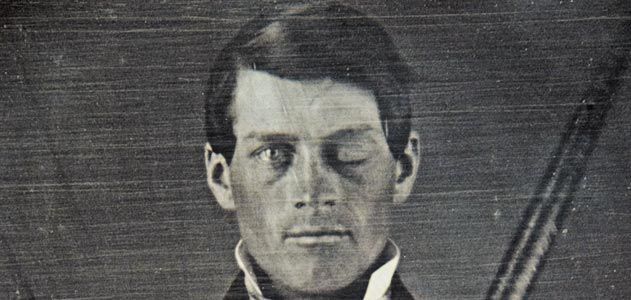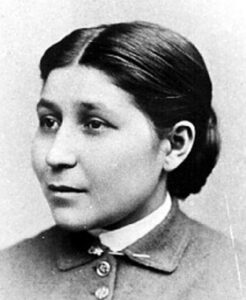It was not an extraordinary day in Cavendish, Vermont. To most people, this day was perfectly normal. September 13, 1848 was just another Wednesday. Phineas Gage, a foreman working for Rutland & Burlington Railroad, would have agreed that this day was no different from any other. Or, at least that’s how it started.1
On this day in September 1848, Gage was only 25 years old. Gage, by all means, was not extraordinary. He was very average. He stood at 5 feet 6 inches, and he was physically strong, as was needed for his job. He was kind, well-mannered, intelligent, and had a good temper. On this day, Gage was putting explosive powder into an iron. It was part of his job, and something he had done before. Gage, a cautious man, usually paid attention to what he was doing. For some reason, he turned his head for a second. He looked away. That was all it took. In one second, his life changed forever.2
The powder Gage was putting into the iron activated, causing an explosion. Surprised, he didn’t have a time to react. The force blew him from where he was standing, and he landed a couple of feet away from his original position. The iron rod went through his left cheek and then out of his skull. Days later it was found by Gage’s men, about 80 feet away from where Gage landed, smeared with blood and brain.3

Miraculously, Gage didn’t pass out from the impact or the bleeding. He got up, went to the town, went into a hotel, and waited there for a doctor. All with little help. When the local doctor arrived, Gage spoke to him and said, “Doctor, here is business enough for you.” Dr. Williams couldn’t believe him — if his story was true and an iron went through his head, how was Gage still standing and talking? How was he fully conscious? It wasn’t until an Irishman standing nearby added to their conversation, stating the rod was still on the floor over by the railroad, “all blood and bits,” that Dr. William believed him.4
Dr. Williams, realizing he wasn’t exactly qualified to treat Gage’s injury called over Dr. John Harlow. In today’s terms, calling Dr. Harlow a neurosurgeon wouldn’t be correct. At this time, neuroscience wasn’t even known, much less an actual field of study. Still, Dr. Harlow treated Gage and managed to stop the hemorrhage Gage had. Even though Phineas Gage experienced severe trauma, he didn’t seem very bothered, nor did he show any signs of stress. Gage even told the doctor that he didn’t want his friends or family to come visit him. After all, his accident wasn’t very serious, and he would return to work in a couple of days time. Through this process, Gage was conscious, and the traces left by the iron and rust were a testament to his accident.5
It took a while for Gage to recover. Not surprisingly. Dr. Harlow kept a clear record of his whole treatment. He kept an almost day-by-day journal filled with his observations, as well as the treatment Gage was receiving. He had an infection, but as Dr. Harlow treated it, it went away fairly quickly. At times during his recovery, Gage would sometimes seem delirious, but that would clear up almost immediately. It was remarkable.6 Really, no one would have guessed what was truly wrong with him until they analyzed him fully. On top of his head, there was an inverted tunnel showing where the rod had come out of. On his left cheek, there was a hole. Small pieces of Gage’s brain appeared scattered throughout his scalp, stuck to his hair. Dr. Harlow described in his report later on, that as he pressed against Gage’s skull, “The pulsations of the brain were distinctly seen and felt.”7 A month later, Gage was able to stand and walk around. Neurologically, he appeared in tact.

The news of his accident quickly spread. Soon enough, Gage was the main topic for articles in his town. This, however, was not what lead to his fame, in fact, Gage wasn’t exactly flourishing after this accident. It was the opposite.
Physically, he wasn’t much different than before. He was still physically capable, although his left eye would stay shut forever, and the left side of his face was partially paralyzed.8 Dr. Harlow would even go so far as to say he had fully recovered. Gage stated he felt fine, but he had an odd feeling. But, it was a feeling not even he could describe. He had no pain, but something was different in his head.9

Even though he was physically capable of doing most things, he couldn’t hold down a job. His old employer refused to hire him again. Something had changed, and it wasn’t in Gage’s physical performance. After the accident everyone collectively agreed, “Gage was no longer Gage.”10 Dr. Harlow detailed these changes. Reportedly, Gage’s personality and behavior drastically changed. The capable and efficient man people hired and knew was gone. He was replaced by a different type of man. Gage now used profanity, something he hadn’t done before. He showed little emotion or care for his coworkers and previous friends. He was irrational, with a short temper.11

Years after the accident, Gage continued to find himself unemployed. His ill-advised decisions caused by his new personality didn’t land him very far. Instead, Gage sought other ways to make money.12 He exhibited himself as a circus act, carrying the famous iron rod. Of course, every job he held was short lived, and he wasn’t a circus act his whole life. He also traveled traveled. He went from through New England, all the way to Chile. His jobs were mostly manual types of work, like driving a stagecoach. Throughout all his travels, he carried the rod with him, like it was a part of him, his only companion.13
In 1860, at the young age of 36, Gage began to experience seizures. He returned home to California, where he reunited with his mother and sister, his only family. Dr. Harlow would later report that after every epileptic convulsion, Gage had no memory of them. Eventually, on May 21st, 1860, after a series of continuous seizures, Phineas Gage died. It was exactly, “twelve years, six months and eight days after the date of his injury.”14

Phineas Gage’s story, as well as the later exhumation of his bones, led to the discovery and subsequent explorations of the brain. His story is one that’s commonly looked at, and it is referred to as “Neuroscience’s most famous case.”15 It led to advancements in what we now know about brain injuries, and how to treat them. Still, sometimes Phineas Gage himself is forgotten. He should be remembered not just as a case, or as an interesting phenomenon, but as a person. He was a good-looking, kind, confident, assertive, young man.16 He had a family, friends, and lived a good life. He was an ordinary man, who experienced an extraordinary injury. And, we should never forget him for that.
- John Martyn Harlow, “Recovery from the passage of an iron bar through the head,” Publications of the Massachusetts Medical Society 2, no. 3 (1868): 4. ↵
- John Martyn Harlow, “Recovery from the passage of an iron bar through the head,” Publications of the Massachusetts Medical Society 2, no. 3 (1868): 4. ↵
- TL Guidotti, “Phineas Gage and His Frontal Lobe- The “American Crowbar Case”,” Archives of Environmental & Occupational Health 67, no. 4 (2012): 249. ↵
- Malcolm Macmillan, Odd Kind of Fame: Stories of Phineas Gage (Cambridge: MIT Press, 2000), 43-44. ↵
- John Martyn Harlow, “Recovery from the passage of an iron bar through the head,” Publications of the Massachusetts Medical Society 2, no. 3 (1868): 7. ↵
- Andrew Grieve, “Phineas P Gage—‘The man with the Iron bad’,” Trauma 12, no 3 (2010): 172. ↵
- John Martyn Harlow, “Recovery from the passage of an iron bar through the head,” Publications of the Massachusetts Medical Society 2, no. 3 (1868): 5. ↵
- TL Guidotti, “Phineas Gage and His Frontal Lobe- The “American Crowbar Case”,” Archives of Environmental & Occupational Health 67, no. 4 (2012): 249-250. ↵
- John Martyn Harlow, “Recovery from the passage of an iron bar through the head,” Publications of the Massachusetts Medical Society 2, no. 3 (1868): 12. ↵
- TL Guidotti, “Phineas Gage and His Frontal Lobe- The “American Crowbar Case”,” Archives of Environmental & Occupational Health 67, no. 4 (2012): 249-250. ↵
- John Martyn Harlow, “Recovery from the passage of an iron bar through the head,” Publications of the Massachusetts Medical Society 2, no. 3 (1868): 11-12. ↵
- Encylopedia of Social Psychology, 2007, s.v. “Social Cognitive Neuroscience,” by Matthew D. Lieberman. ↵
- TL Guidotti, “Phineas Gage and His Frontal Lobe- The “American Crowbar Case”,” Archives of Environmental & Occupational Health 67, no. 4 (2012): 249-250. ↵
- John Martyn Harlow, “Recovery from the passage of an iron bar through the head,” Publications of the Massachusetts Medical Society 2, no. 3 (1868): 14. ↵
- Andrew Grieve, “Phineas P Gage—‘The man with the Iron bad’,” Trauma 12, no 3 (2010): 173. ↵
- TL Guidotti, “Phineas Gage and His Frontal Lobe- The “American Crowbar Case”,” Archives of Environmental & Occupational Health 67, no. 4 (2012): 250. ↵




50 comments
Victoria Davis
I have never before heard of this story, but I am so glad I did. Phineas was really affected emotionally for a miracle that should not have ever happened but turned out to be a medical phenomenon. It was really crazy to me how he survived and continued to live on. This article was so intriguing and interesting to read.
Nicole Ortiz
Wow, this was such a crazy and interesting story to read that I had never heard about or read until today. It’s unbelievable that Phineas experienced such trauma and didn’t die from it. I wonder how it was even possible that he experienced that personality change, one might think that with all of the technology we have now, someone would know how it was even possible to have happened. Really good and interesting article.
Carly Jimenez
This is actually a really great article! I think you must be a real strong person to go through all that and not let it phase you. What i think is more interesting is that in that time neurology was not really known but his doctor sure did a good job of helping him the best he knew how. What I find sad about this is that he couldn’t hold a job after his accident mainly because of the way he looked. I this is the first time I am hearing the story of Gage. I think you did a good job. This was very interesting.
Michael Thompson
This was a fun story, with a medical phenomenon with no advanced medicine. It was a miracle that shouldn’t have happened, especially in that century. It sounds like it was really the first of its kind. I think it is really cool, that it didn’t effect him physically, at least not at that point, but it did effect him emotionally.
Addie Piatz
This story was very interesting. I hadn’t even heard of him before this but I am glad that i read this article. I think its crazy and honestly just a straight up miracle that he lived and carried on normally after his accident especially since they really didn’t have the education they do now for Neurologically. I am very glad I read this article it was so intriguing.
Shea Slusser
I have never heard of Gage or his story prior to reading this, but it sound like his case made quite an impact in the medical field and discoveries they captivated from it. It’s sad to know his personality traits began to change after the fact, but it seems clear this was because of the incident, and not from the Gage prior to the incident. Interesting story and perhaps a miracle he was able to live from it.
Rosa Robledo Martinez
Phineas Gage was important in psychology and neurology, because of his accident. Many people thought that he should have been dead, because the iron rod went through his skull. I am glad that he was able to do mostly everything even after his accident he lived a semi ordinary life. This article was well written and explained everything from his early life to why he is important in psychology.
Ashley Martinez
I had recently learned very briefly about Phineas Gage during a psychology college class. This accident that occurred to Phineas Gage was a major discovery specifically to psychology, sociology, and neurology. It is extremely fascinating that Phineas Gage lived after this horrific accident. You would have assumed that Gage would have died instantly due to the impact the rod had on his brain. But instead this accident affected Gage’s personality. It is amazing to see how the brain functions and which parts control certain functions. It is extremely sad that Gage was not the same person he was before the accident and greatly impacted the rest of his life after specifically pertaining to holding a job. This was a great article packed with great information.
Rahni Hingoranee
Gage’s story is an important one in psychology and neurology. I can imagine the way that people around him at the time were shocked when he was still walking and talking as if nothing had happened after his horrible accident. It is sad to learn he was unable to hold down a job thereafter because his mishap was mostly a freak accident.
Kaleb Werku
What a crazy story the fact that he just shrugged off that insane injury is crazy to me I know it might be bad but I respect him for that. His case is an example of how complicated our brain is and how much we don’t know about it especially when this happened. It is sad though that his life was permanently effected by this. He couldn’t even keep a job.